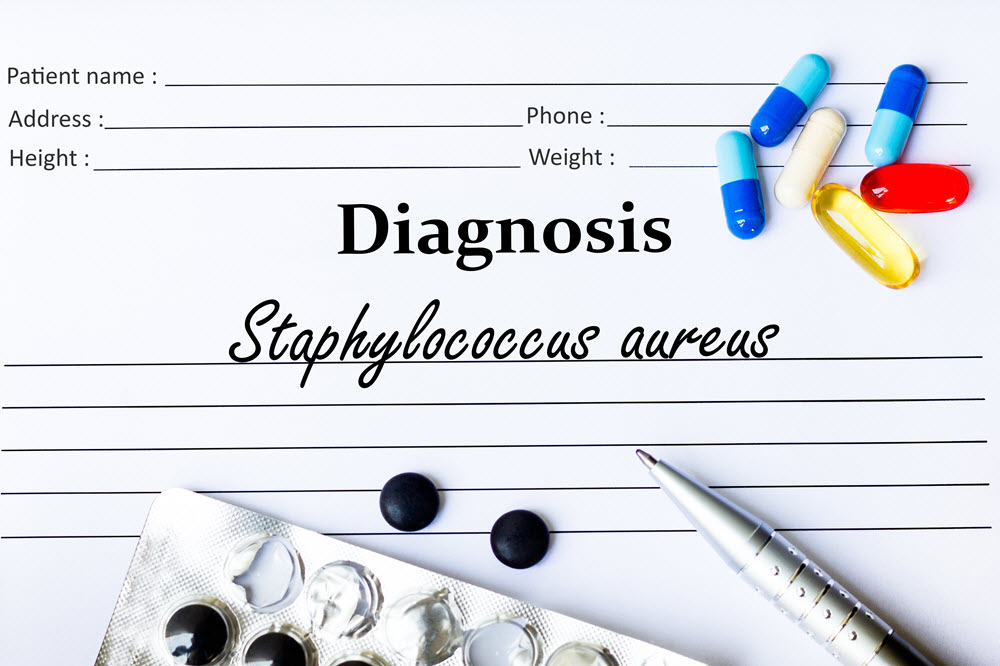Note: The Pregistry website includes expert reports on more than 2000 medications, 300 diseases, and 150 common exposures during pregnancy and lactation. For the topic Staphylococcus aureus, go here. These expert reports are free of charge and can be saved and shared.
__________________________________
You might have heard of Staphylococcus aureus, which is the name of a species of bacteria that shows up naturally on many people’s skin and in their noses, but you also may have more commonly heard it called “staph.” While this bacterium is naturally occurring, it can cause infections, too. In this post, we’ll discuss what to look out for when it comes to staph infections and how they might affect your pregnancy, birth, and postpartum period.
Staph infections during pregnancy
Staph infections are not particularly common during pregnancy, but it’s always good to watch out for any infection during pregnancy, as your immune system (the body system that protects you from germs) is less active while you’re pregnant, meaning some infections are harder to fight off.
Many symptoms are associated with staph infections. Usually how they manifest depends upon how the bacteria get into the body. While Staph aureus is typically present on the skin, if you get a cut and it gets infected with staph, it might look like pimples, boils, or a reddened, swollen region. Sometimes there is also pus. This type of staph infection is the most common type and is usually treated with antibiotics. Good hygiene, including lots of hand-washing, can help prevent this type of infection.
There is a special kind of staph called MRSA (methicillin-resistant Staphylococcus aureus) that about 1 in 20 people carries on their skin. This type of staph does not respond with certain antibiotics, so you’ll have to have a different antibiotic if you get an infection with this type. MRSA may be more common in people who have spent lots of time in hospitals.
Your care provider will likely test the germs in your infection to see which type of bacteria you have so that you get the best treatment. If you are taking antibiotics or using topical antibiotics and your infection doesn’t start getting better after a day or two, call your care provider to check-in. You may need a different medication.
Staph infections during breastfeeding
The most common type of staph infection that you might get during breastfeeding is mastitis, an infection in your breast tissue. Just like the skin infections mentioned above, this type of staph infection usually happens because some skin bacteria get into the breast tissue through a cut or abrasion caused by breastfeeding. If you have sore, cracked nipples, mastitis is especially likely.
Symptoms of mastitis include a hardened, sore area on one or both breasts, red streaking on your skin near the sore spot, fever, chills, and extreme fatigue. If you have any of these symptoms, call your care provider right away. It may not be a staph infection, but any bacterial infection in your breast can be dangerous and can come on quickly. Your care provider will likely encourage you to continue to breastfeed or pump while you take antibiotics for the infection, and antibiotics are safe for your breastfeeding baby.
Staph and food poisoning
Staph can also be the cause of food poisoning, which is miserable whether you’re pregnant or breastfeeding (or none of the above). Unlike other causes of food poisoning, this variety can’t be avoided by cooking the food properly because the symptoms are caused by a toxin that the bacteria release that hangs around after cooking, not the bacteria themselves, which can be killed by heating. The main treatment for this type of food poisoning is to wait it out while monitoring and treating your symptoms.
You want to be especially careful about food poisoning during pregnancy because it often leads to dehydration and gastrointestinal distress that’s more dangerous than when you’re not pregnant. Extreme dehydration can even bring on labor. And dehydration is rough during breastfeeding, too, because being able to make enough breast milk depends upon you being well hydrated.
The way to avoid food poisoning, whether it’s due to staph bacteria or not, is to wash fresh veggies and fruits carefully and to make sure cooked meat has been heated to recommended temperatures. Avoid food that has been improperly stored or not refrigerated, like that potato salad that sat out at the family barbecue all afternoon. If you eat food that wasn’t prepared at home, make sure you trust the person or establishment to follow good food safety practices.

